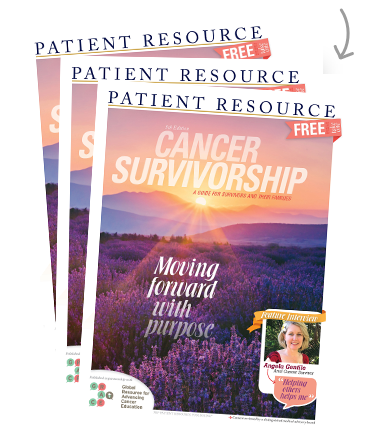Survivorship
Overview
People who face cancer have stories that are as unique as they are, and they define survivorship in their own ways. Some people consider themselves survivors upon receiving a cancer diagnosis. Others take on the role once they have moved past active treatment. Still others prefer no label at all. No matter how you define it or where you are in your story, this guide is for you: the forward-thinking, strong person who is living with, through or beyond cancer.
Cancer survivorship is sometimes described in phases:
- Acute survivorship starts at diagnosis and ends when initial treatment is over. The focus is on treating the cancer and minimizing or managing side effects.
- Extended survivorship spans the months and years following initial treatment. The focus is on monitoring for symptoms of late effects or signs of a recurrence or second cancer; treatment continues for those with chronic disease to stop/slow progression, maintaining quality of life.
- Long-term survivorship is when years have passed following initial diagnosis and treatment. The focus is on annual/periodic follow-ups and addressing any major health issues developing because of treatment.
According to the Surveillance Research Program, Division of Cancer Control and Population Sciences, National Cancer Institute, the number of survivors is increasing. Approximately 16.9 million cancer survivors were counted in the U.S. in January 2019. By January 2030, it is estimated that number will be more than 22.1 million. Advances in early detection, innovations in treatment options and improvements in side effect management can be credited with the increasing number of survivors.
Preparing For Your Next Phase
For many people, cancer-related effects don’t often disappear when treatment ends. Recovery from the physical, emotional and mental aspects of cancer can take a great deal of patience and more time than many survivors and their families expect. This content is designed to help prepare you for the path ahead. You may have challenges, and you may find new opportunities.
Though you may have originally planned to celebrate when active treatment was complete, you may be second guessing yourself. You may fear that having a party could jinx the cancer into recurring. Or, because you are looking at the world with a different lens now, you may feel differently about what was important to you before your cancer diagnosis.
These feelings are common, and they can be very confusing for you as well as for your family, friends and co-workers. Don’t expect to jump back into the routine you had before you were diagnosed with cancer. Resuming activities, or changing them entirely, may take time. Be patient as you adjust to this next phase of your life. Be prepared to explain to others that this has been a life-altering experience and that some things, such as where you see your priorities today, may have changed.
Survivorship and the self-reflection that often accompanies it can pave the way for new experiences and different choices. Look for these and embrace them.
Some larger cancer centers and community treatment centers provide survivorship clinics and programs for adults who’ve had cancer treatment, or you can search online for one. Consider joining a cancer support group. There is still more to learn, and sharing your knowledge could offer hope to other survivors. Your nurse navigator or a cancer support organization can provide a list of resources.
Remember, you are not alone. Your community extends past active treatment. It can be a lifelong source of friendship and support.
Take Advantage of all Telehealth Has to Offer
Though you may have fewer and less frequent medical appointments during survivorship, you will still have them. Telehealth may offer you a convenient option for staying on schedule with these important visits.
Telehealth is the delivery of health care from a distance using technology such as computers, cameras, video conferencing, the internet and smartphones. You may hear it referred to as a “virtual appointment.”

Virtual appointments are not designed to replace in-person visits and are not recommended for first-time visits. Instead, they are an alternative for later face-to-face visits. At this point in your cancer care, you have likely already developed a relationship with your oncologist, making this a possible option for you. You may consider telehealth for these reasons:
- You may hesitate to leave home because of an increased risk of infection.
- You may have a fever or not feel well.
- You may not have transportation.
- It may be difficult physically for you to get to an appointment.
- You may live far from the medical facility.
Ask your health care team if telehealth is available for you. To participate, you will only need a device, such as a smartphone, tablet or computer, and an internet connection. And don’t worry if you don’t consider yourself to be tech-savvy.
These appointments are conducted through patient portals or on another video or web conferencing platform. Typically, you will receive instructions in advance from your health care provider’s office on how to prepare for the appointment.
Annual Celebration Spotlights Survivors
Every year on the first Sunday in June, cancer survivors, loved ones, cancer advocates and health care professionals across the U.S. celebrate National Cancer Survivors Day by participating in community events. The goal of this inspirational day, themed “A Celebration of Life,” is to increase awareness about the ongoing challenges of cancer survivorship. It’s a chance for everyone who has lived with cancer to observe the milestones they’ve reached and recognize those who have supported them along the way. Learn how to get involved and discover more cancer survivorship resources.



